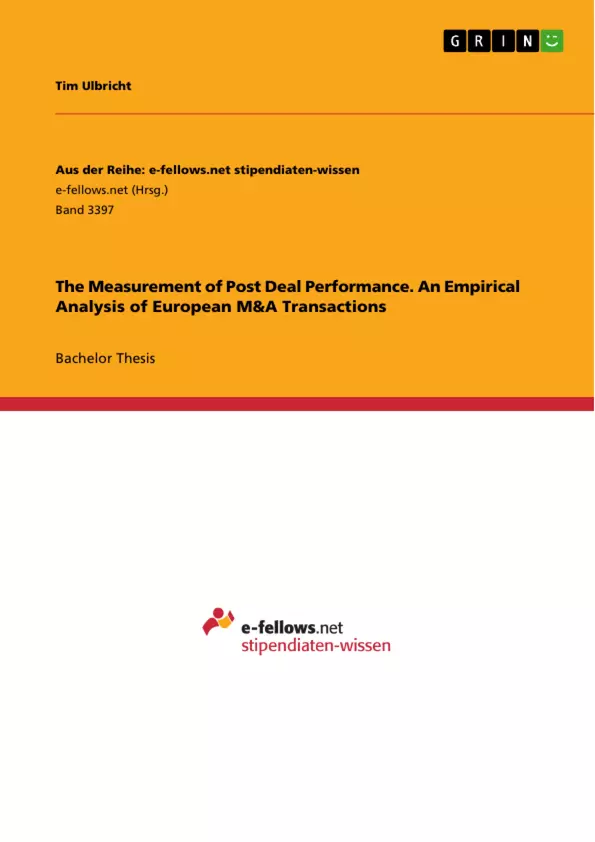There are several studies that showed that on average 50% of all M&A deals lead to a failure. There are some explanations for the high rate of failures in empirical research, e.g. hubris which is the overconfidence of the management as first mentioned by Roll or managerialism. Still M&A transactions take place frequently and shareholders do not prohibit them. Cartwright & Schoenberg suggest that this unchanged acceptance of shareholders for M&A activities exists because there are some synergies or gains, but the measures used in research do not acknowledge them properly. They state that in a market environment such inefficiencies (value destroying M&A transaction) are hard to believe.
I want to contribute to this debate by identifying, describing and finally analyzing several measures that are used in research and apply them on the same sample. According to Thanos & Papadakis the used measure in a study seems to highly influence the outcome. They found that return on assets (ROA) measures often lead to a negative outcome while cash flow measures often lead to a positive outcome. They state that the usage of several measures in the same study could lead to more robust results. There are a lot of different measures used to analyze M&A performance. Meglio & Risberg divide these measures into a financial domain including measures for market performance and measures for accounting performance and a non-financial domain including measures for operational performance and measures for overall performance. In my empirical analysis I will focus on accounting and market measures due to data availability. The accounting measures can be separated into three major categories: ratios, growth measures and operating cash flows.
I will start with a literature review to examine what measures are used to measure M&A Deal performance in research. Therefore, I categorize the accounting measures according to the framework of Thanos & Papadakis like described above and add the market measure abnormal returns to my analysis. Following my literature review I will discuss the pros and cons of the different measures and which measures seem eligible in which situation. After that I will analyze European M&A transactions using data from the Thomson Eikon Databank. Most research focuses on US M&A deals which results in an underrepresentation of research for European transactions. By analyzing the latter, I address this problem.
Inhaltsverzeichnis (Table of Contents)
- Introduction
- Literature Review
- Accounting Measures
- Ratios
- Growth measures
- Operating Cash Flows
- Abnormal Returns
- Other Measures
- Measure Comparison
- Accounting Measures
- Empirical Analysis: European M&A Transactions
- Research Design
- Sample
- Model
- Variables
- Results
- Research Design
- Discussion
Zielsetzung und Themenschwerpunkte (Objectives and Key Themes)
This thesis aims to investigate the effectiveness of various accounting and market-based measures in gauging the post-deal performance of European M&A transactions. The study seeks to empirically assess the relationship between these measures and the long-term financial performance of acquiring companies.
- Measuring post-deal performance in M&A transactions
- Evaluating the effectiveness of accounting and market-based measures
- Analyzing the relationship between performance measures and long-term financial performance
- Examining the applicability of these measures to European M&A transactions
- Contributing to the understanding of M&A performance measurement in a global context
Zusammenfassung der Kapitel (Chapter Summaries)
The thesis begins with an introduction that provides background information on M&A transactions and the importance of post-deal performance evaluation. This is followed by a comprehensive literature review, which explores various accounting and market-based measures used to assess post-deal performance. The chapter also discusses the methodologies and limitations of previous studies. The empirical analysis chapter delves into the research design, outlining the sample selection, model specifications, and variables used in the study. The results section presents the findings of the empirical analysis, highlighting the relationships between different performance measures and long-term financial outcomes. The discussion chapter interprets the results in the context of previous research and examines their implications for M&A practitioners and researchers.
Schlüsselwörter (Keywords)
This study focuses on key terms related to mergers and acquisitions, post-deal performance measurement, accounting measures, market-based measures, empirical analysis, and European M&A transactions. The research explores concepts like return on assets, return on sales, profit growth, asset growth, sales growth, operating cash flow returns, abnormal returns, and cumulative abnormal returns, employing statistical techniques to analyze their relationship with long-term financial performance.
- Citar trabajo
- Tim Ulbricht (Autor), 2018, The Measurement of Post Deal Performance. An Empirical Analysis of European M&A Transactions, Múnich, GRIN Verlag, https://www.grin.com/document/584714



